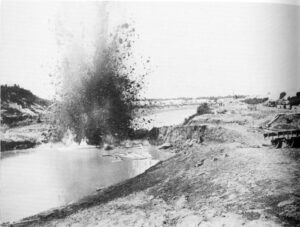Constructing the Trent – Severn Waterway
The first idea of a navigable waterway through the lower and upper Great Lakes came about in the 1700s for the fur trade, but was solidified immediately after the War of 1812: during that conflict, the British had difficulty supplying and reinforcing their garrisons on Georgian Bay, Lake Huron, and Lake Superior, and in campaigning against American forts and bases on the upper Great Lakes. A secure water route between Lake Ontario and Georgian Bay would solve this problem. Several government-sponsored surveys undertaken between 1815 and 1827 determined that the Trent-Otonabee-Severn river system was the best option. However, the Trent-Severn Waterway would not be completed until 1920, thus making it Canada’s longest-lasting public construction project.
In 1833, James Bethune built a lock at Bobcaygeon. Locks at Buckhorn, Burleigh, Fenelon Falls, and Lindsay followed, and made transportation north and west of Peterborough easier.
Political issues (usually involving funding), opposition from lumbermen and those with interests in hydro-electric power production, and the expansion of railways in  the province all contributed to delaying the waterway’s construction. In August 1895 work began on the Peterborough-Lakefield Division. Engineering innovations in this sector included concrete locks instead of limestone ones, and the hydraulic lift lock at Peterbrough. Navigation opened in 1904.
the province all contributed to delaying the waterway’s construction. In August 1895 work began on the Peterborough-Lakefield Division. Engineering innovations in this sector included concrete locks instead of limestone ones, and the hydraulic lift lock at Peterbrough. Navigation opened in 1904.
Begun at the same time as the Peterborough-Lakefield section, the stretch between Lake Simcoe and Balsam Lake took three years longer to build because of, as James Angus notes in A Respectable Ditch:A History of the Trent-Severn Waterway, 1833-1920, “construction delays and political skulduggery”.
Next completed was the Ontario-Rice Lake Division (1908-18); the steamboat Kitchener was first to sail from Lake Ontario to Orillia and back — with requisite dignitaries, of course. Finally, the division from Lake Simcoe to Port Severn was finished. On 23 June 1920, a blast of dynamite turned the 386 kilometre waterway from Lake Ontario to Georgian Bay from an idea into a reality.
Today, Parks Canada operates the Trent-Severn Waterway. Between May and October every year, its 37 conventional locks, two flight locks, two hydraulic locks, and marine railway play host to thousands of recreational boaters from all over the world.
By: Don Willcock
On behalf of The Peterborough Museum & Archives
300 Hunter St E, Peterborough, 705-743-5180
www.peterboroughmuseumandarchives.ca
Photo Credit: Cyanotype print (like a blueprint). – Trent Severn Waterway




